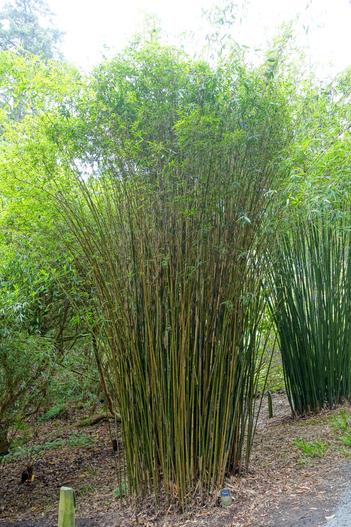Candy Cane Bamboo
(Himalayacalamus falconeri)
Candy Cane Bamboo (Himalayacalamus falconeri)
/
/

Daderot
CC0
Image By:
Daderot
Recorded By:
Copyright:
CC0
Copyright Notice:
Photo by: Daderot | License Type: CC0 | License URL: http://creativecommons.org/publicdomain/zero/1.0/deed.en | Uploader: Daderot | Publisher: Wikipedia Commons


Estimated Native Range
Summary
Himalayacalamus falconeri, commonly known as Candy Cane Bamboo, is an evergreen perennial grass native to the understory of temperate forests and along forest margins in the Himalayan region. It typically grows to a height of 12-25 feet (4-8 meters) with slender culms that are about 0.1 feet (0.03 meters) in diameter. The culms of Candy Cane Bamboo are particularly notable for their striking coloration, which includes shades of red, yellow, and green, resembling the stripes of a candy cane. This species flowers infrequently, and the flowering events can be sporadic and unpredictable.
Candy Cane Bamboo is valued for its ornamental striped culms and its ability to create a tropical look in temperate gardens. It is used for creating visual interest in garden borders, as a privacy screen, or as a feature plant in Asian-themed gardens. It requires protection from strong winds and prefers a sheltered position. While it thrives in full sun, it can also tolerate part shade. Candy Cane Bamboo is adaptable to a range of soil types, provided they are well-draining. It is relatively low-maintenance but may require occasional thinning to manage its spread. Gardeners should be aware that, like many bamboos, it can become invasive if not properly contained with root barriers or by planting in pots.CC BY-SA 4.0
Candy Cane Bamboo is valued for its ornamental striped culms and its ability to create a tropical look in temperate gardens. It is used for creating visual interest in garden borders, as a privacy screen, or as a feature plant in Asian-themed gardens. It requires protection from strong winds and prefers a sheltered position. While it thrives in full sun, it can also tolerate part shade. Candy Cane Bamboo is adaptable to a range of soil types, provided they are well-draining. It is relatively low-maintenance but may require occasional thinning to manage its spread. Gardeners should be aware that, like many bamboos, it can become invasive if not properly contained with root barriers or by planting in pots.CC BY-SA 4.0
Plant Description
- Plant Type: Grass
- Height: 12-20 feet
- Width: 3-10 feet
- Growth Rate: Slow
- Flower Color: N/A
- Flowering Season: Non-Flowering
- Leaf Retention: Evergreen
Growth Requirements
- Sun: Full Sun, Part Shade
- Water: Medium
- Drainage: Slow, Medium, Fast
Common Uses
Edible*Disclaimer: Easyscape's listed plant edibility is for informational use. Always verify the safety and proper identification of any plant before consumption., Low Maintenance
Natural Habitat
Understory of temperate forests and along forest margins in the Himalayan region
Other Names
Common Names:
Scientific Names: , Himalayacalamus falconeri, Drepanostachyum falconeri, Thamnocalamus falconeri, Arundinaria falconeri, Arundinaria nobilis, Arundarbor falconeri, Bambusa fistulosa, Fargesia gyirongensis, Himalayacalamus gyirongensis,
GBIF Accepted Name: Himalayacalamus falconeri (Hook.f. ex Munro) Keng f.